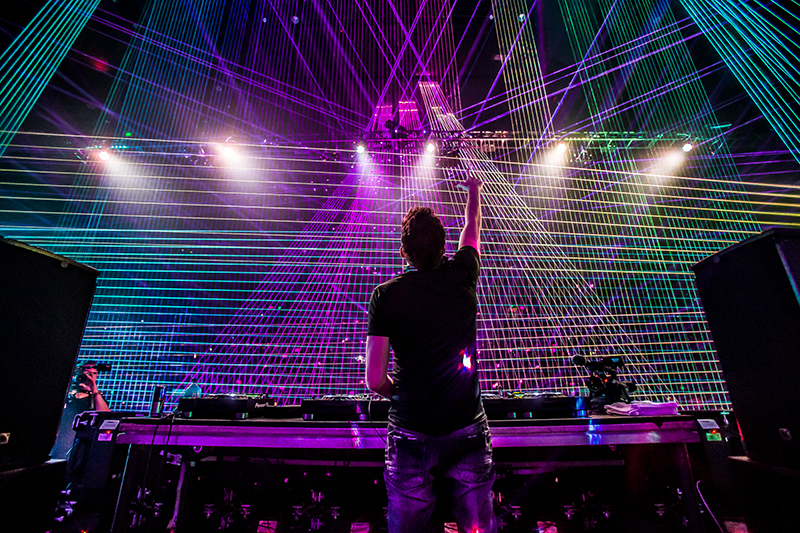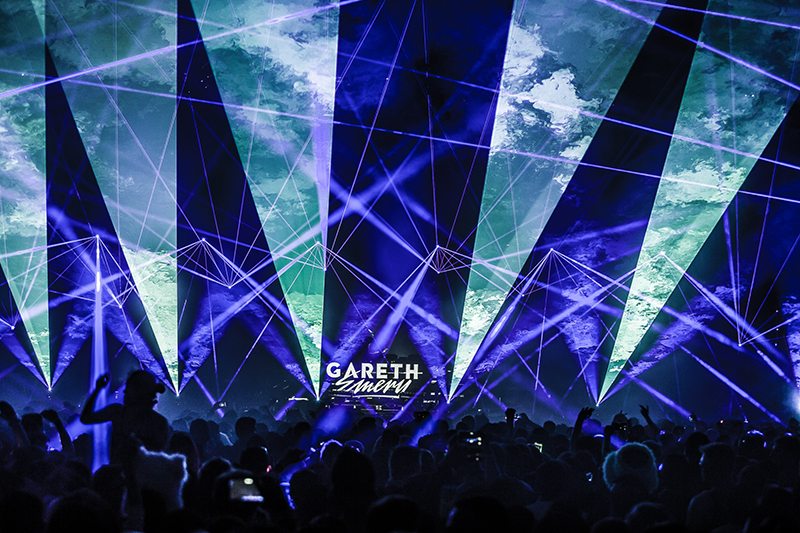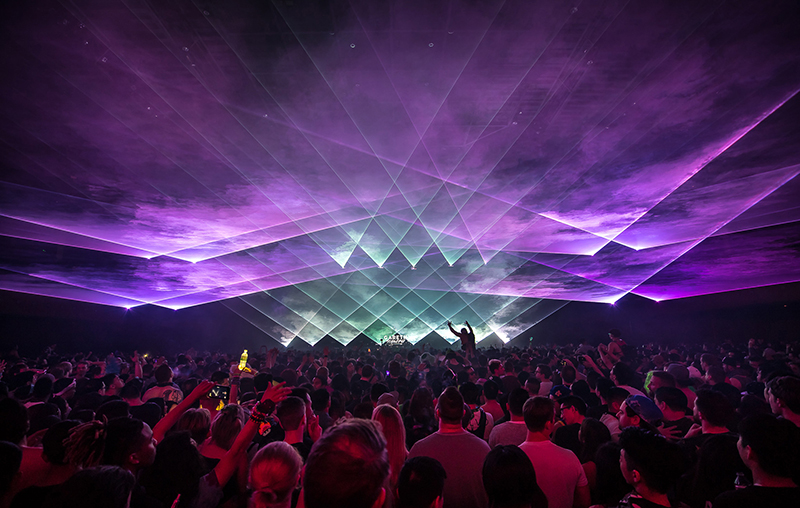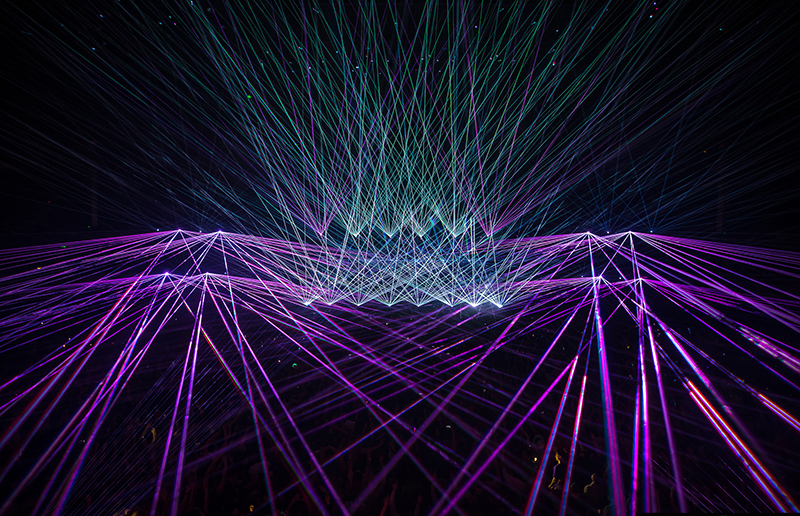Gareth Emery’s stage show, known as Laserface, was a unique presentation with more than 100 lasers deployed within San Francisco’s Bill Graham Civic Auditorium. The event, staged March 17, requiring the collaboration of four separate vendors from the tightly knit laser community.
Shane Martz, owner of Dynamic FX provided lasers and production management expertise. Adam LaBay of Future Weapons served as Laser Safety Officer and provided a dozen of Kvant’s 20W Spectrum lasers and audience scanning lasers, including eight Kvant ClubMax 6000 units and 18 ClubMax 4000 lasers. Pangolin Laser Systems provided their new Beyond 4.0 BETA software with FB4 control and PASS audience scanning laser technology.
Nice Lasers owner Anthony Garcia, Gareth’s tour manager and designer, also called upon ER Productions, with their vast experience designing laser shows, from small to Guinness World Record scale, (as seen at LDI 2017) to provide laser beam bars, power and network distribution.

“There are only a very few companies that could provide this many lasers without suffocating their inventory,” notes Dynamic FX owner Shane Martz. “People just don’t do laser shows of this scope and caliber. It took the phenomenal team we had in San Francisco to pull it together for Laserface, along with the excellent gear.”
“With a show like Laserface, you need a company that not only can provide enough quality equipment; you also need knowledgeable people to help build it,” adds Nice Lasers owner Anthony Garcia. “I’ve worked with Lawrence Wright from ER Productions and knew they would be a good asset to the team.” ER designed the power and network distribution and provided advanced network setup for FOH.
ER Productions’ Lawrence Wright noted that Anthony Garcia from Nice Lasers specified 16 of ER’s audience scanning lasers, 16 of ER Storm lasers and 64 ER Blade lasers. ER Productions’ proprietary E-Stop system, Wright adds, “provided an additional layer of safety, giving Laser Safety Officer (LSO) Adam LaBay the ability to disable the lasers if the need arose.”

Safe and Fast
Every laser show requires a Laser Safety Officer (LSO). Normally a laser show is performed with Class 4 overhead lasers with no audience interaction. For a big audience scanning show like Laserface, an LSO with an audience scanning variance is a necessity.
To get an audience scanning variance is a difficult process which requires a great deal of time, effort and training. With it, you can project lasers into the audience using specially built equipment and following strict operational procedures to keep everything safe and legal.
To make the lasers safe for the audience, a laser is manufactured with the Pangolin PASS audience scanning system. PASS monitors laser power, scanner signals and other projector-related parameters. If there are any problems, laser output is interrupted. All audience scanning lasers were certified for audience scanning safety prior to the event and were monitored during the event at all times. LaBay is one of a handful of licensed LSO’s in the U.S.A that can legally fill this role.
“To do something like this, combined with the type of complex programming that Anthony [Garcia] does, requires incredibly fast processing power,” LaBay says. “The network and control software has to have no lag whatsoever,” he adds, citing the benefits of Pangolin Beyond for show control.
Along with his LSO expertise, LaBay is a laser designer as well. One of his most famous pieces is the Windows 10 desktop image. This image is installed by default on every Window 10 computer, making it one of the most recognizable laser images of all time. It was created entirely out of lasers on a practical film shoot Adam LaBay was responsible for.
“Adam LaBay, my partner in crime who runs Future Weapons, supplied the brand new 20 watt Kvant Spectrum lasers which formed the centerpiece surrounding Emery on the stage,” says Garcia. “These are the brightest I have ever seen, and we built the rest of the rig around them.”

Setting the Stage
Garcia, a laser and lighting designer in his own right, first crossed paths with Gareth Emery, EDM artist and creator of the Laserface concept, while operating lasers at one of Gareth Emery’s Electric for Life events in 2015. The two met briefly afterwards, thanked each other, and that, presumably, was that, as far as Garcia could tell.
A year later, Garcia answered an Instagram post. Emery was looking for a tour manager. He initially hired Garcia as a VJ, later adding tour manager responsibilities. Interestingly enough, considering the scope and intensity of the production that became Laserface, Emery told Garcia at the time, “We don’t need lasers on every show, but we always need visuals.”
Garcia still found time for his original passion, creating time coded laser shows, which he considers an art form. “It really had no larger purpose than making videos of my art projects and posting them on my Facebook page. Gareth saw my work on Facebook and asked me if we could recreate something like it live.”
This was the conversation Garcia had been hoping for. “In my first interview with him, I told him that my goal is to one day give him the type of show that Laserface became.”

The Bill Graham Civic Auditorium, which Emery chose to present Laserface in San Francisco, “is one of the most beautiful rooms I’ve ever been in,” said Garcia, “and it is massive. The challenge, for me, was how to make the room feel intimate. I wanted to fill up the room with beams and the crowd to feel involved.”
To achieve this, Garcia wrapped the room with lasers on truss running along the length of house left and right. A truss at front of house loaded with lasers directed towards the performance area complemented the array of lasers flown and on the floor of the stage.
Kvant’s new Spectrum 20W with FB4, supplied by Future Weapons, were used for high power aerial effects. Each Spectrum contained ultra-fast Pangolin Saturn 5 Scanners, capable of projecting complex and vivid laser content. As each laser has its own Pangolin FB4 interface, all lasers were able to be independently controlled and had lightning fast reaction speed.
Explaining his affinity to lasers, Garcia points out the risk that, “with visuals I think you kind of lose the crowd to the giant screen on stage. With lights, you can only get them to move so fast. The reason I like to program and design with lasers is their ability to move so quickly and change color instantly. These scanners are projecting a laser at a resolution of 60,000 points per second. It’s the perfect fixture to design with. The audience scanning lasers can safely project into the crowd and surround them with cones of beams, or immerse them with a ‘liquid sky’ or a wave of light. When people are standing in the laser beams, rather than beams just flying overhead, it really creates a whole new experience as they are now in the laser show.”
The Kvant ClubMAX 6000 with PASS was used for audience scanning effects. Kvant systems were the first in the U.S. to become audience scanning certified, and the new ClubMAX line integrates Pangolin’s PASS hardware in a unique way, providing legal setup and control of audience scanning laser shows. Currently Pangolin’s PASS hardware is the only FDA approved laser system, for audience scanning effects in the USA.
“As I listen to Gareth, I’m really just translating from music to light,” says Garcia. “Rather than try to give people a show with a narrative in addition to music in the background, I’m just trying to translate and give the crowd something beautiful to see.”

The Front End
With the large number of lasers and complexity of the show presentation, a new approach for control was required, notes Shane Martz. “We had to distribute processing power for control across three computers with timecode,” he says. “We chose Pangolin’s Beyond software with the new 4.0 Beta version, as we needed to take advantage of some of the great new features they offer.”
The show was controlled by timecode using a system called TC Supply. Working with the Pioneer DJ department, TC Supply devised a way to send encoded information from the CDJ-2000 Turntable player over Ethernet to a laptop running the TC Supply software. This displays the track(s) being played and its info in this software allowing the operator to choose what song should be running over the other in the mix, and then spits the timecode for that chosen track to the three laptops running Beyond. Each laptop had specific areas of lasers to control that were only assigned to that laptop for distributed processing of so many cues and effects across the lasers.
Garcia controlled the ER Laser Blades — accounting for more than half of the total laser unit count, at 64 — with a grandMA2 full size lighting console.

Networking for Success
Garcia and Martz have a professional as well as personal relationship which has grown over the years. As the scope of the show took form, Garcia realized he not only needed the Dynamic FX lasers projectors, but Martz himself to handle pre-production logistics and be on location in San Francisco to handle to show setup and manage the laser crew. For Martz, his biggest challenge was wrangling the 122 laser projectors from the various vendors and resolving all the pursuant logistics during the five days the production had to prepare.
In the old days, lasers used to be run by analog cable — DB25, similar to the 25-pin serial port cables you’d use to connect the Compaq desktop computer you got from CompUSA to your old dot matrix printer. It was a great way to control lasers, but it had many issues. FB4 is a digital network that Pangolin Laser Systems created to resolve these issues. Everything now is run on a high bandwidth network with the capability of doing a lot more, because everything is faster and much easier to work with.
Justin Perry, chief operating officer at Pangolin Laser Systems and Kvant Lasers USA noted, “It was a pleasure to see this variety of different companies from across the laser industry connect, to bring this immense laser display to life. It really showcased how far laser technology as a whole has come. The artists involved all had a vision of what they wanted to accomplish, and they worked together hand in hand to bring that vision to life!”

Gareth Emery’s Laserface
Staged at Bill Graham Civic Auditorium in San Francisco, CA, March 17, 2018
Crew
- Lead Designer/Production Manager: Anthony Garcia
- Laser Design Co: Nice Lasers
- Lighting Designer: Allan Susanto
- Assistant PM/Laser Crew Chief: Shane Martz
- Laser Safety Officer: Adam LaBay
- Laser Technical Director: Lawrence Wright
- Laser Techs: Cameron Moreno, Garrett Gosting, Matson McCrabb, Michael Ciccone
- Laser Companies: Future Weapons, Dynamic FX, ER Productions
- Laser Control: Pangolin Beyond
- Timecode Synch: TC Supply, LLC
- Video/LED: Show Imaging Inc.
- Special Effects Co: Owl Vision, LLC
- Lighting Co: Felix Lighting
- Backline: AOP Entertainment
- Visual Content: VJCLA
Laser Gear
- 12 Kvant Spectrum 20W lasers
- 8 Kvant ClubMAX 6000 Audience Scanning Lasers
- 18 Kvant ClubMAX 4000 Audience Scanning Lasers
- 8 ER Productions Storm 15W Lasers
- 4 Dynamic FX “Longboi” 15W Lasers
- 64 ER Productions Laser Blades
Related Links:


